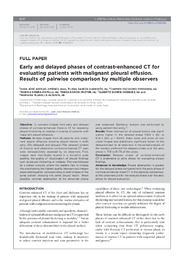Please use this identifier to cite or link to this item:
https://hdl.handle.net/11000/34632Full metadata record
| DC Field | Value | Language |
|---|---|---|
| dc.contributor.author | Arenas Jiménez, Juan José | - |
| dc.contributor.author | García Garrigós, Elena | - |
| dc.contributor.author | ESCUDERO FRESNEDA, CARMEN | - |
| dc.contributor.author | Sirera-Matilla, Marina | - |
| dc.contributor.author | García-Pastor, Irene | - |
| dc.contributor.author | Quirce-Vázquez, Alberto | - |
| dc.contributor.author | Planells-Alduvin, Mariana | - |
| dc.contributor.other | Departamentos de la UMH::Patología y Cirugía | es_ES |
| dc.date.accessioned | 2025-01-16T18:14:22Z | - |
| dc.date.available | 2025-01-16T18:14:22Z | - |
| dc.date.created | 2018 | - |
| dc.identifier.citation | The British journal of radiology. 2018 Sep;91(1089):20180254 | es_ES |
| dc.identifier.issn | 1748-880X | - |
| dc.identifier.issn | 0007-1285 | - |
| dc.identifier.uri | https://hdl.handle.net/11000/34632 | - |
| dc.description.abstract | Objective: To compare images from early and delayed phases of contrast-enhanced thoracic CT for assessing pleural thickening or nodules in a series of patients with malignant pleural effusions. Methods: Blinded images from 36 patients with malignant pleural effusions showing pleural lesions in both early (35 s delayed) and delayed (70 s delayed) phases of thoracic and abdominal contrast-enhanced CT scan were retrospectively assessed by six observers. First, images were individually scored in a six-point scale grading the quality of visualization of pleural findings such as pleural thickening or nodules. This was followed by a paired analysis, where the readers had to choose the one showing the highest quality between two images presented together corresponding to both phases of the same patient showing the same pleural lesion. When possible, contrast attenuation of the abnormal pleura was measured. Statistical analysis was performed by using paired t-test and χ 2. Results: Mean attenuation of pleural lesions was significantly higher in the delayed phase (76.0 ± 25.1 vs 57.5 ± 20.7, p < 0.001). Mean score and score of individual images was statistically significant better for the delayed phase for all observers. In the paired analysis, all the readers preferred the delayed phase over the early phase in 77.8 to 91.7% of the cases. Conclusion: Delayed phase of contrast-enhanced CT is preferable to early phase for evaluating pleural findings. Advances in knowledge: Pleural attenuation is greater for the delayed phase compared with the early phase of contrast-enhanced chest CT. In the pairwise comparison, all the observers prefer the delayed phase over the early phase for pleural evaluation. | es_ES |
| dc.format | application/pdf | es_ES |
| dc.format.extent | 6 | es_ES |
| dc.language.iso | eng | es_ES |
| dc.publisher | British Institute of Radiology. Oxford University Press | es_ES |
| dc.rights | info:eu-repo/semantics/openAccess | es_ES |
| dc.rights | Attribution-NonCommercial-NoDerivatives 4.0 Internacional | * |
| dc.rights.uri | http://creativecommons.org/licenses/by-nc-nd/4.0/ | * |
| dc.title | Early and delayed phases of contrast-enhanced CT for evaluating patients with malignant pleural effusion. Results of pairwise comparison by multiple observers | es_ES |
| dc.type | info:eu-repo/semantics/article | es_ES |
| dc.relation.publisherversion | 10.1259/bjr.20180254 | es_ES |

View/Open:
Early and delayed phases of contrast-enhanced CT for evaluating patients with malignant pleural effusion. Results of pairwise comparison by multiple observers.pdf
681,42 kB
Adobe PDF
Share:
.png)
